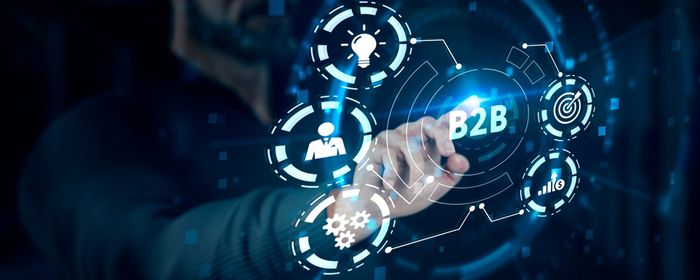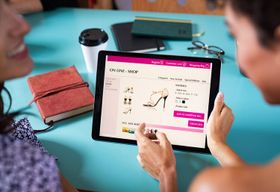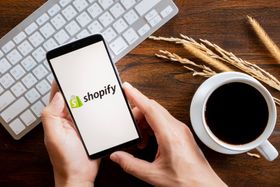B2B vs. B2C Personalization: 5 Key Differences
Updated November 19, 2024.

Personalization is non-negotiable for online shoppers. If more than half of your customers want a curated shopping experience, then it's essential to get it right. But where should you start? It's all about context.
B2B (Business-to-Business) vs. B2C (Business-to-Customer) personalization can help you understand what your customers are expecting and find the right approach to meet those expectations. Below, we take a look at the differences between B2B vs. B2C personalization so you can develop effective personalization strategies.
» Need an intro? Learn what personalization in eCommerce is
5 Key Differences Between B2B vs. B2C Personalization
- Audience characteristics
- Relationship building
- Personalization methods
- Data collection and analysis
- Metrics and ROI
» Discover how personalization can improve your website search results
1. Audience Characteristics
When trying to evaluate the characteristics of your audience, you'll need to look at some critical categories like buying habits, decision-making processes, and expectations.
B2B
A B2B audience is more relationship-driven. You don't just focus on logic and numbers. You also need to build a sense of loyalty and trust. This means that a B2B purchase cycle may take weeks, months, or even years, depending on what's being purchased. Plus, this decision might involve multiple stakeholders, so you'll need to build relationships with all of them.
B2C
In contrast, a B2C audience is more product-driven. This means you'll need to focus more on selling the value of the products while appealing to emotion and using easy-to-understand language. A B2C shopper also has a much shorter purchase cycle than a B2B buyer, especially if the item is relatively inexpensive.
2. Relationship Building
To build long-lasting customer relationships, you'll need to be trustworthy, reliable, and consistent, no matter who your customers are.
B2B
Building on our previous point, the relationship-building process should be more in-depth in a B2B environment. These customers have higher expectations for what you're bringing to the table and how you show up.
After all, you're not simply selling a product—you're giving expert advice and delivering custom solutions for specific business challenges. This means your communication with B2B customers will also be more intimate via meetings, calls, or email exchanges.
Pro tip: If you have a sales team that speaks directly with buyers, we recommend using a customer relationship management (CRM) platform to keep track of critical details, like who you're speaking with, what you're discussing each time you engage, and how the purchase is moving through the pipeline.
B2C
Your customer relationships aren't necessarily as intimate as those in B2B. Because you're serving a larger audience, you communicate with your customers all at once via different digital channels like websites, mobile apps, and social media. Your focus is also to build trust with your audience and demonstrate why your brand and products are better than your competitors.
Pro tip: Build credibility and social proof with reviews, surveys, and user-generated content.
» Delve deeper into how user-generated content creates conversions and increases brand loyalty
3. Personalization Methods
All audiences, regardless of who they are and what they're buying, want to see information that's relevant to their wants and needs.
B2B
In the B2B world, your predictive personalization methods must be focused and relevant to the customer's industry and business model. The average B2B buyer will read 13 pieces of content before deciding which vendor they'll go with.
On the other hand, someone buying a case for their iPhone likely won't be doing such thorough research. This means proving your credibility and value in different ways, including:
- Showcasing your expertise through reports and research.
- Establishing your customer service through case studies and customer testimonials.
- Offering dynamic pricing structures and product packages to meet customer needs.
- Assigning a specific account manager to offer personalized advice.
B2C
Because B2C has a shorter purchasing cycle than B2B, you're trying to encourage customers to buy now. Plus, if they had a pleasant shopping experience, they'll come straight to you next time instead of browsing competitors. You can personalize the B2C shopping experience by:
- Making personalized product recommendations and taking advantage of upsell and cross-sell opportunities.
- Offering personalized pricing strategies.
- Giving custom rewards through loyalty programs.
- Using behavioral retargeting to showcase tailored ads.
» Find out how to create the best personalization experience on your eCommerce store
4. Data Collection and Analysis
While both B2B and B2C businesses use strategies like website tracking (e.g., Google Analytics) and third-party data sources, their data collection and analysis differ in terms of volume, complexity, sources, and goals.
B2B
While B2B has a lower data volume, its data collection and analysis are more intricate and detailed. Because the goal is to build long-term relationships with customers and offer personalized business solutions, you must collect detailed information about your business customers' companies. You can collect data from:
- Account management platforms.
- Customer support systems.
- Email exchanges.
- Interactions with multiple role-players in the business.
B2C
B2C has a large data volume because it serves a large customer base made up of multiple individuals, each with their own needs and preferences. To offer personalization to a large audience and improve their shopping experience, you need to divide your audience into segments—for example, according to behavior or demographics. But before you can segment and analyze data, you have to collect it from the right sources:
- Customer interactions on your website.
- Customer activity on social media.
- Customer feedback through reviews, surveys, comments, or emails.
» Use these customer segmentation strategies to grow your eCommerce business
5. Metrics and ROI
Both B2B and B2C businesses must measure the effectiveness of their personalization strategies to identify areas for improvement and optimize future campaigns.
B2B
Because B2B transactions have longer sales cycles and more complex decision-making processes, the metrics you track focus on monitoring the different stages of your sales pipeline. This can include lead-to-opportunity conversion rates, average deal size, sales velocity, and win/loss ratios to understand and improve your sales performance.
Additionally, you'll calculate ROI (Return on Investment) at the account or customer level because you're aiming to establish long-term relationships. You'll look at factors like revenue generated, margins, and the costs associated with acquiring, serving, and retaining customers.
B2C
In comparison, because B2C has shorter sales cycles, you'll look at metrics that focus more on immediate customer actions. This can include conversion rates, average order value, and repeat purchase rates.
When calculating ROI in B2C, you'll focus on specific campaigns, channels, or marketing initiatives and their impact on sales, conversions, and customer acquisition costs.
» Don't get caught out: Customer personalization vs. segmentation
The Fast Lane to Personalization
To successfully implement personalization and effectively engage and retain customers, it's critical that you understand the key differences between B2B and B2C audiences.
Just keep in mind that you'll likely need to experiment until you find your perfect combination of strategies. Create a plan, test your personalization strategies, and analyze your performance. Once you've found your personalization sweet spot, you can effortlessly grow your eCommerce business.
» Discover more ways personalization can help your business




